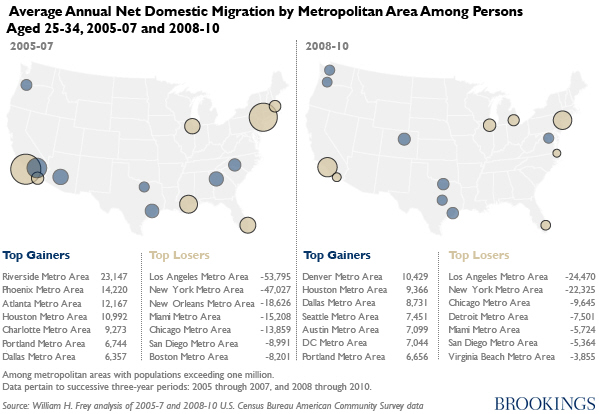Changing Youth Migration Patterns: So Long New York, Hello… Portland?
A new blog post from William H. Frey, senior fellow at the Brookings Institution, takes a look at the migration patterns of American youth, and the cities that attract the “cool” crowd. In the last few years, the rough economy has put the brakes on mobility, which has declined to its lowest levels since World War II. Young adults in particular have stopped moving around. Still, like always, there are those 20 and 30 somethings who remain mobile. But, in recent years their list of destinations has begun to change. Frey writes:
While young people are moving less than before, it is interesting to see where those who did move went. Heading the list are Denver, Houston, Dallas, Seattle, Austin, Washington D.C., and Portland. The top three areas and our nation’s capital, arguably, fared relatively well economically during the recession. But all seven are places where young people can feel connected and have attachments to colleges or universities among highly educated residents.
As illustrated in the chart below (courtesy of Brookings) the “Top Gainers” of young people age 25 – 34, from 2008 – 2010 are: Denver, Houston, Dallas, Seattle, Austin, DC, and Portland. The “Top Losers” are Los Angeles, New York, Chicago, Detroit, Miami, San Diego, and Virginia Beach.

But what are the qualities that make a city attractive to the young people in this survey? The big (obvious) answer is jobs. But beyond that, perhaps affordable housing, a low cost of living, a transportation and bicycle infrastructure, an arts culture, and of course, the prospect of being around other young people. Frey writes:
To the extent they are moving at all, young adults are headed to metro areas which are known to have a certain vibe—college towns, high-tech centers, and so-called “cool cities.”
Last month, the Wall Street Journal ran a piece on the “Next Youth Magnet Cities,” and asked six experts (including William Frey) to pick the 10 cities they thought would lead the way in attracting young people. They included big ones like New York, Chicago and Boston, with Seattle tying for first place with D.C. They also included Raleigh, Dallas, and San Jose.
What are some other non-job related factors that make a “cool city?”

Comments